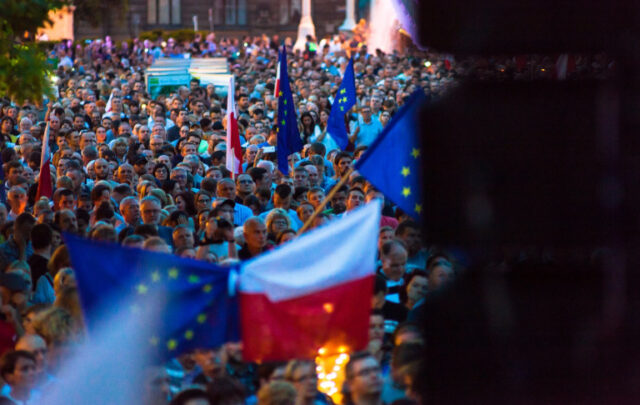LOS ANGELES — The last thing Alex Thacher wanted was to jump from the frying pan into the fire, from the molasses of Washington, D.C., traffic to an even more gut-churning commute here. So Thacher found an apartment in Pasadena next to a light-rail station. He leaves his building, steps onto a train and walks into his downtown L.A. office 40 minutes later.
That’s a bit longer than driving but stress-free and cheaper — parking costs $200 a month, but his firm reimburses for rail fares. Thacher and his wife, Tiffany, stroll two blocks to one of the region’s trendiest shopping and entertainment districts — Old Pasadena’s Colorado Boulevard.
“We hated the commute in D.C. It was awful,” says Thacher, 29, a lawyer with PricewaterhouseCoopers. “Now I get on the train and read the paper or do some work. From what I understand, all around here is just a miserable commute.”
He’s got that right. Greater Los Angeles has some of the nation’s nastiest congestion. Traffic on the Pasadena Freeway — Thacher’s route if he drives — crawls at rush hour. The future looks worse because the region can’t add freeway capacity fast enough to handle 6.3 million new residents expected by 2030, experts say.
But Thacher and many others are surprised to learn that driving is no longer the only option here. Since the 1980s, Los Angeles has quietly built a mass-transit network — subway, commuter rail, light rail, rapid bus — that’s slowly taking strain off roads. Development around that network is taking off. New housing near transit hubs is in sharp demand by commuters like Thacher.
Shifting housing demographics are stoking interest around the USA in development near transit, according to a study for the Federal Transit Administration released last month. City living draws singles, aging baby boomers, minorities and young couples more than suburban families with kids. And those groups are growing faster than suburbanites.
“Suburbs want to remake themselves around transit to capture that demographic, and urban communities are suddenly becoming desirable again,” says Hank Dittmar, the study’s author and president of Reconnecting America, a non-profit group focused on transportation and community issues.
Los Angeles isn’t alone. The study predicted that by 2025 nearly 15 million U.S. households will want to rent or buy near transit, double today’s number. Demand will be highest in regions that have extensive systems — New York City, Boston, Chicago — and those with large growing systems like Los Angeles.
But many other cities are converts. Portland, Ore., has been a leader in creating density around transit. San Diego is investing heavily next to rail. Denver’s downtown redevelopment focuses on transit. The Miami regional transit agency’s new chief is a developer pushing projects close to commuter rail stations. Salt Lake City’s light rail is attracting developer interest.
A project on Dallas’ light-rail line near Southern Methodist University mixes entertainment, dining, high-end retail and housing. At least five cities on a rail line between San Francisco and San Jose are planning “transit villages.”
L.A. challenges myth
From Hollywood to Long Beach to Pasadena, this megalopolis of 17 million is one of the nation’s hottest centers of development linked to mass transit. Across the region, more than 40 projects worth nearly $6 billion are underway or have opened since 2000.
“The myth everyone believes is that L.A. — from Randy Newman to the Beach Boys — is all about cars. The place where the freeway was born, where you drive to the house two doors down,” Dittmar says.
That image is changing. The metro area is running out of places to spread more subdivisions. Housing must be packed more densely into Los Angeles and adjacent cities if growth is to be managed. Developers see the potential of turning scores of aging strip malls and random real estate into housing. Pair those trends with clogged freeways and smog, high gas prices and the lifestyle costs of tedious commutes, and transit gains appeal.
Tinseltown isn’t exactly Transit-town — yet. Trains and buses provide just 5% of the region’s trips, the Metropolitan Transportation Authority says. But transit’s share is rising, and even small shifts in L.A.’s travel habits can pay huge dividends. MTA estimates, for instance, that boosting car-pooling from 1.1 occupants per car to 1.3 would eliminate most freeway congestion.
The gold standard for residential development near transit stations is Arlington County, Va., across the Potomac River from Washington, D.C., urban planners say. In the 1970s, Arlington decided to concentrate development along its 3-mile subway route to maintain the character of suburban neighborhoods. That was novel and controversial at the time.
But the results are impressive: 35,000 residents living in 18,000 houses and apartments, 75,000 jobs, 1,900 hotel rooms and 17 million square feet of office and retail space within walking distance of subway stations. The half-mile-wide corridor contains just 7.6% of Arlington’s land but generates a third of its tax revenue, keeping residents’ property tax bills lower than anywhere else in the region.
Neighboring Fairfax County opted for massive parking facilities around its subway stations and shunned the housing-office-retail mix. A result was more sprawl throughout the county. Now plans at two stations for clusters of residential towers have sparked neighborhood opposition over traffic. Only 30% of the newcomers would commute by subway, studies show.
“In Arlington, three-fourths of people walk to the train,” Dittmar says. “In Fairfax, two-thirds drive. The difference is just dramatic.”
Pedestrian-friendly spaces are critical, planners say. Arlington learned from early mistakes that buildings had to open onto sidewalks and invite walking. If a goal is to cut car trips — only a fourth of all trips are work trips — give residents fewer reasons to drive by mixing shopping, housing and entertainment, planners say. It will lead to fewer cars per household.
Offer housing choices — apartments, condos, townhouses and single-family homes. Single uses such as office buildings make for dead after-hours downtowns. Mixing uses creates 24-hour villages and more transit ridership.
Barely a decade ago, Arlington’s Clarendon neighborhood was economically stagnant with aging housing and limited retail stock. Today, it’s one of metro Washington’s hippest areas. Bars and restaurants hum late into the night. Commuters rushing home pack upscale groceries for gourmet dinner dishes.
Atlanta took a bold crack at a transit village, Lindbergh City Center, but overstuffed it with office space and parking structures, then isolated housing between a rail line and a freeway. “It’s essentially a suburban office park,” Dittmar says. “The neighborhood completely freaked out.”
Sprucing up Los Angeles
Los Angeles seems to be getting it right, too. Transportation officials see nothing short of an urban renaissance as thousands of new city dwellers inhabit lofts and condos converted from historic office buildings and warehouses. Transit is a big part of it.
Nearly 300 apartments will be finished next year near Union Station, an Art Deco jewel and nexus of bus, rail and subway a few blocks from City Hall. Major projects rise near Gold Line light-rail stations in Pasadena and South Pasadena, with more planned in Chinatown and other neighborhoods.
Seedy sections of Hollywood, including the commercial and theater district around the Walk of Fame, have been revitalized by Red Line subway openings since 1999. At crime-plagued Hollywood Boulevard and Western Avenue, on MTA donated land, a dilapidated building was torn down and 120 affordable apartments went up over the subway station. Across the street is a new supermarket and mall.
Developments at two Wilshire Boulevard subway stops will add nearly 600 housing units, plus a new middle school. Stores and 199 apartments are planned at MacArthur Park, a block of condos, stores and a hotel at Hollywood and Vine.
“Aspects people around the world associate with Hollywood have been restored,” says Gordon Olschlager, a project manager with design firm Nakada & Associates.
As transit expands further, new projects will follow. The Blue Line light rail that runs south from Union Station has sparked $1 billion in development at Long Beach stations where the route ends. A 5-mile Gold Line extension into densely populated, mostly Latino east L.A. is underway. A 24-mile extension east to San Bernardino County will open rail access to tens of thousands of commuters in the San Gabriel foothills.
Mass transit on two of the USA’s most brutal commutes — the 10 mph rush-hour creep from the San Fernando Valley and west L.A. into downtown — could halve drive times. Light rail will run from downtown past the Staples Center to Culver City and eventually Santa Monica. Orange Line rapid buses will run 14 miles through the Valley on restricted roadway paralleling clogged U.S. 101. Bus drivers will have control of traffic lights to cut down on intersection stops.
Officials believe that even though the Orange line isn’t rail, developers will be won over by permanent stations, the core of any urban village, built at mile intervals. “The way we’re doing it, it will have the same kind of economic impact as rail,” MTA chief Roger Snoble says.
So far, the building splurge hasn’t boosted transit use much. Subway, bus and rail ridership has been flat since 2002. The Gold Line especially — 14,000 daily boardings — has been disappointing, but officials note that it runs only 13.7 miles and new links will pick up more riders. The subway took years to attract 111,000 weekday passengers.
Initial opposition fades
Most of L.A.’s high-density urban projects meet not-in-my-backyard resistance, even though developments around transit invariably raise neighborhood property values. “The community kicks up a huge fuss because it’s the end of the world,” Snoble says. “Then on opening day you can’t keep people off the podium.”
Pasadena’s building spree since 2000 sparked a backlash, and the city retreated to an earlier, more deliberate master plan.
“There are elected officials who will resist the notion of this kind of development and higher density,” says Jeff Lustgarten, spokesman for the Southern California Association of Governments. “But we view the alternative as pretty grim.”
Michael Dieden built Mission Meridian — lofts, townhouses and detached, single-family houses with street-level retail and underground parking — in affluent, traditional South Pasadena one block from a Gold Line station. Neighbors were wary. But Dieden says, “When you develop density with high design and do it in a sensitive way, it becomes acceptable even to those traditionally critical of it.”





